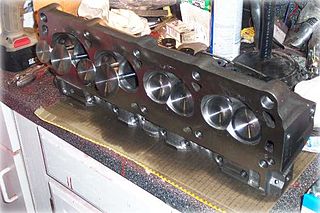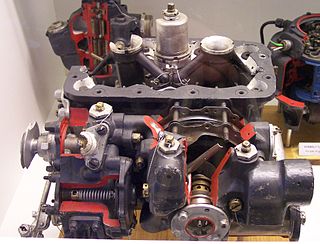
A turbocharger, colloquially known as turbo, is a turbine-driven, forced induction device that increases an internal combustion engine's power output by forcing extra compressed air into the combustion chamber. This improvement over a naturally aspirated engine's power output is because the compressor can force more air—and proportionately more fuel—into the combustion chamber than atmospheric pressure alone.

A carburetor or carburettor is a device that mixes air and fuel for internal combustion engines in an appropriate air–fuel ratio for combustion. The term is sometimes colloquially shortened to carb in the UK and North America or to carby in Australia. To carburate or carburete means to mix the air and fuel or to equip with a carburetor for that purpose.

In an internal combustion engine, the cylinder head sits above the cylinders on top of the cylinder block. It closes in the top of the cylinder, forming the combustion chamber. This joint is sealed by a head gasket. In most engines, the head also provides space for the passages that feed air and fuel to the cylinder, and that allow the exhaust to escape. The head can also be a place to mount the valves, spark plugs, and fuel injectors.

A fuel pump is a component in motor vehicles that transfers liquid from the fuel tank to the carburetor or fuel injector of the internal combustion engine.

A cold air intake (CAI) is usually an aftermarket assembly of parts used to bring relatively cool air into a car's internal-combustion engine.

CVCC, or Compound Vortex Controlled Combustion, is an internal combustion engine technology developed and trademarked by the Honda Motor Company.

In automotive engineering, an exhaust manifold collects the exhaust gases from multiple cylinders into one pipe. The word manifold comes from the Old English word manigfeald and refers to the folding together of multiple inputs and outputs.

In automotive engineering, an inlet manifold or intake manifold is the part of an engine that supplies the fuel/air mixture to the cylinders. The word manifold comes from the Old English word manigfeald and refers to the multiplying of one (pipe) into many.

Alfa Romeo Twin Spark (TS) technology was used for the first time in the Alfa Romeo Grand Prix car in 1914. In the early 1960s it was used in their race cars to enable it to achieve a higher power output from its engines. And in the early and middle 1980s, Alfa Romeo incorporated this technology into their road cars to enhance their performance and to comply with stricter emission controls.

A ram-air intake is any intake design which uses the dynamic air pressure created by vehicle motion to increase the static air pressure inside of the intake manifold on an internal combustion engine, thus allowing a greater massflow through the engine and hence increasing engine power.

An intake is an opening, structure or system through which a fluid is admitted to a space or machine as a consequence of a pressure differential between the outside and the inside. The pressure difference may be generated on the inside by a mechanism, or on the outside by ram pressure or hydrostatic pressure. Flow rate through the intake depends on pressure difference, fluid properties, and intake geometry.
"Genesis" is Yamaha's marketing name for a range of innovative high performance multi-valve motorcycle engines. The flexible design of the engine allowed Yamaha to use it on a variety of configurations, from sport bikes to outboard engines.
Carburetor, carburettor, carburator, carburettor heat is a system used in automobile and piston-powered light aircraft engines to prevent or clear carburetor icing. It consists of a moveable flap which draws hot air into the engine intake. The air is drawn from the heat stove, a metal plate around the exhaust manifold.
A throttle is the mechanism by which fluid flow is managed by constriction or obstruction.
In engine technology, a reverse-flow or non-crossflow cylinder head is one that locates the intake and exhaust ports on the same side of the engine. The gases can be thought to enter the cylinder head and then change direction in order to exit the head. This is in contrast to the crossflow cylinder head design.
A heated air inlet or warm air intake is a system commonly used on the original air cleaner assemblies of carburetted engines to increase the temperature of the air going into the engine for the purpose of improving the consistency of the air/fuel mixture to reduce engine emissions and fuel usage. This is especially useful during cold or winter climates, when the engine is being started, to help with initial combustion and to bring the engine to optimum operating temperature.
A velocity stack', 'trumpet, or air horn, is a trumpet-shaped device of differing lengths which is fitted to the air entry of an engine's intake system, carburetor or fuel injection.

This article briefly describes the components and systems found in jet engines.
Internal combustion engines come in a wide variety of types, but have certain family resemblances, and thus share many common types of components.

Of the three types of carburetors used on large, high-performance aircraft engines manufactured in the United States during World War II, the Bendix-Stromberg pressure carburetor was the one most commonly found. The other two carburetor types were manufactured by Chandler Groves and Chandler Evans Control Systems (CECO). Both of these types of carburetors had a relatively large number of internal parts, and in the case of the Holley Carburetor, there were complications in its "variable venturi" design.














